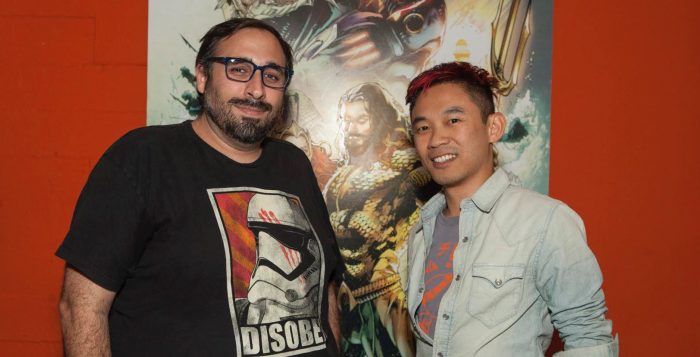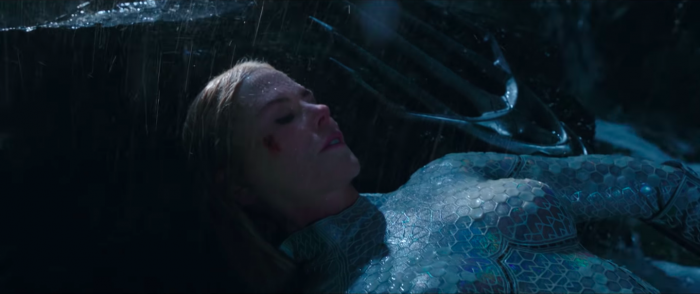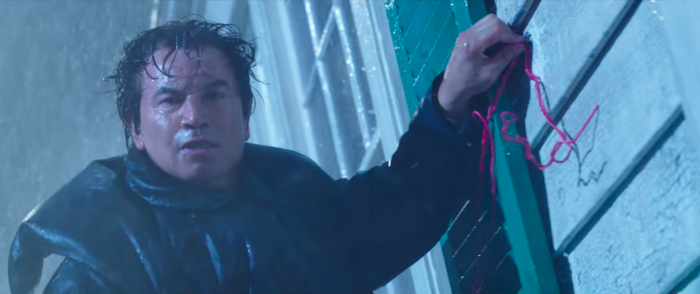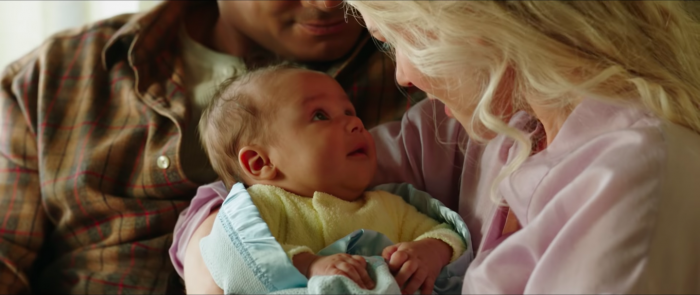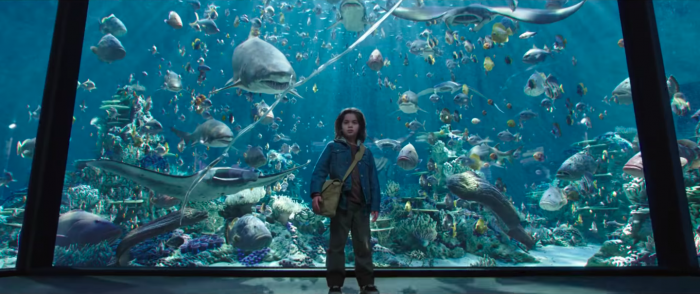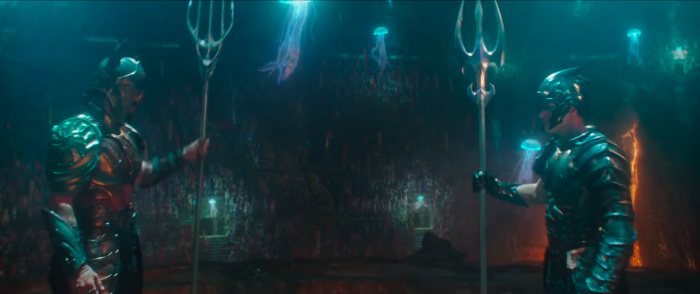Inside The 'Aquaman' Editing Room: James Wan On Embracing The Fun And Camp
On August 16, 2018, I visited the Warner Bros studio lot in Burbank California to visit the editing room of Aquaman. The film had just held a test screening the previous week, and director James Wan and editor Kirk M. Morri were hard at work implementing changes and finishing the film. We got to see over 20 minutes of footage and talk to the filmmaker about the latest DC Universe movie.
Walking into the Aquaman production office, one thing was evident — they are on a sprint to finish this movie. Usually, offices like these are scrubbed of spoilers, especially when a group of the press is visiting. All the signage in the office used the film's code name "Ahab," as you might expect. But some parts of the office were in full work mode, not caring who noticed the details. For instance, on the wall was a whiteboard of VFX shots that they were still waiting to be finalized, in film chronological order. I won't spoil the details here but the last scene on the list clearly read to me as an after credits scene, so expect to stay in your seats during the credits.
In the editing room, we met up with James and Kirk behind their editing console in a dark room with the windows completely blacked out. I'm there alongside a handful of other film journalists to see some footage and ask some questions. What follows is a transcript of our Q&A and description and impressions of the screened footage.
We were just talking, I love the horror movies. Are you gonna go back to directing horror movies again? Like, I love that you're producing them, but I wanna see you get back into it.James Wan: I will. That's a promise. I will get back to it at some point. I mean, even Sam Raimi did right? After Spider-Man he went back, and did [Drag Me To Hell]. That was so much fun. So, yeah, but I gotta find the right project, because I think when I go back to horror, that'll be quite a spotlight on it, so I just wanna make sure that it's something I really dig.Yeah. This is such a massive production, but you're used to like doing multiple projects at the same time, so has this been different?James Wan: It's like handling, like The Conjuring spinoffs, and like La Llorona and doing all that, but then, this is a big monster of a film, and just, trying to juggle all the plates in the air, make sure nothing drops. It's a bit of a handful, but I've got lots of great people working on the different projects. So, yeah. So ...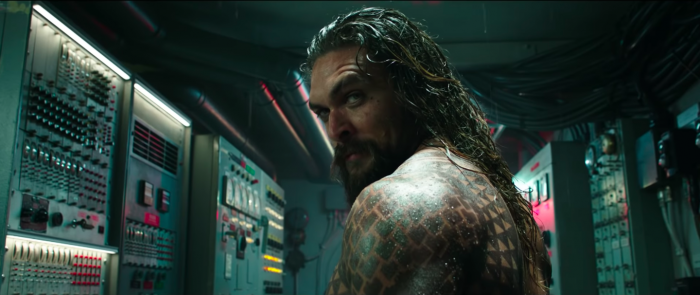 Is it difficult to remain in control of it, because it's such a well-established character, and you're dipping into the DC world? Is that hard for you to give it your own style?James Wan: With this particular film, no, not really. I mean, obviously, certain elements have already been established from Justice League, but I'm really coming into this, and just pretty much making my own movie. And, what I'm gonna show you guys, you guys are gonna see, it's a bit different. I think it has my stamp all over it. I'm literally still in the midst, but I'll give you my disclaimer. It's in the midst of like, I'm putting it together. A lot of visual effects work is to be done, you know, sound, mix, color, and all that stuff. But I mean, yeah. I'm here to show you guys what we've been working on.
Is it difficult to remain in control of it, because it's such a well-established character, and you're dipping into the DC world? Is that hard for you to give it your own style?James Wan: With this particular film, no, not really. I mean, obviously, certain elements have already been established from Justice League, but I'm really coming into this, and just pretty much making my own movie. And, what I'm gonna show you guys, you guys are gonna see, it's a bit different. I think it has my stamp all over it. I'm literally still in the midst, but I'll give you my disclaimer. It's in the midst of like, I'm putting it together. A lot of visual effects work is to be done, you know, sound, mix, color, and all that stuff. But I mean, yeah. I'm here to show you guys what we've been working on.
Just a quick question, were any of you guys at Comic-Con panel for this?
Yeah.James Wan:Well, okay. So, most of you have already seen the Comic Con piece, but that's what I usually start off with. Would you guys wanna check that out, again?James then showed us the extended Aquaman footage that they screened at San Diego Comic-Con 2018, and has not been published online. We've already recapped and given our opinions on this piece, so we'll skip it for this write-up. The questions for the filmmaker continued.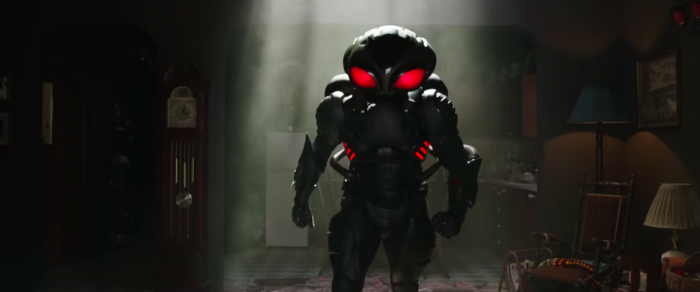 Was it a challenge to adapt Black Manta so faithfully, and actually have it not look incredibly goofy? How did you actually pull that off?James Wan: This is the piece that we played at Hall H that didn't get out, but we've just [added] some visual effect shots that have been updated. And, that's all I'm doing. Since what I showed in the trailer, and all that stuff, my visual effects shots have just like been updated, updated, updated. So, it's a process that's gonna be updated, up 'til the end, to the release of the film. Yeah. I mean, listen, getting Black Manta right, for me, was a prime directive for me, very early on, with designing the whole look of the film. The movie's such a design heavy film, and that is one aspect of it. Obviously, getting it right was super important for the fans, and obviously, for myself as well, and ultimately for the people that are not familiar with him 'cause he's a pretty strange looking guy. It's a very strange look.
Was it a challenge to adapt Black Manta so faithfully, and actually have it not look incredibly goofy? How did you actually pull that off?James Wan: This is the piece that we played at Hall H that didn't get out, but we've just [added] some visual effect shots that have been updated. And, that's all I'm doing. Since what I showed in the trailer, and all that stuff, my visual effects shots have just like been updated, updated, updated. So, it's a process that's gonna be updated, up 'til the end, to the release of the film. Yeah. I mean, listen, getting Black Manta right, for me, was a prime directive for me, very early on, with designing the whole look of the film. The movie's such a design heavy film, and that is one aspect of it. Obviously, getting it right was super important for the fans, and obviously, for myself as well, and ultimately for the people that are not familiar with him 'cause he's a pretty strange looking guy. It's a very strange look.
And so, I know that I wanna stay true to what people are familiar with of him in the comic book. But also for the non fans, they can look at that, and kind of go, "Oh, he's weird, but it's practical." It's somewhat of a diving suit, potentially, and stuff like that. So, yeah, we worked on him a lot at the pre-production, very early on, to try to get him right.
You can see my early designs up here, like just the different stages. It's super cool. Keeping his head big, and his eyes big, was very important for me.
So in comic book history, Atlantis has got a really complicated past. There are a lot of layers, and a lot of complicated things happening. What was the most important thing about Atlantis as a society for you to pull from the comics, and put on the big screen?James Wan: Right. Definitely for me, in terms of source material, there's so much, such rich, sort of materials to pull from, right? By however many years of storyline to be pulling from. I definitely wanted to focus whatever I was doing with Atlantis, was stuff that I needed to tie it back to my main characters, to tying back to Patrick Wilson's character, King Orm, and his sort of background, his idea of what Atlantis is, and then also, having a bit of history lesson in there about what Atlantis was before it sank.
And, we all know that sort of mythology of that which is, they were so advanced. So, it's a period in a lot of ways, but then that was sort of their undoing, right? And so, kind of playing a little bit into that touching, on that wall, as well.
Yeah. Definitely trying to pull things from the comic that serves as our story, but then also bearing in mind for non fans out there, that I need to bring as much sort of history from the comic book world. Then also, kind of making it not so deep, so that a non-fan would have a hard time following. That kind of balance, yeah.
Are you gonna be touching like on all seven kingdoms, or is it the case, of the story allows for only this many, and you'll do whatever you can in the future?James Wan: Spoiler. I mean, seven kingdoms is a lot of kingdoms. And just right off the bat, you can tell that there's the world of Atlantis, which is where King Orm and where Arthur is technically the rightful ruler, right? He's the rightful heir to the throne. And so, we definitely touch on Atlantis, but then we also know that Dolph Lundgren's character is in there, as well, and he's the king of the kingdom of Xebel. So we know we touch on that. And in the trailer, you see we touch on the wall of the trench. And, we go out into the desert. So, we touch on the desert kingdom, as well. And, I feel there are other surprises in there that I wanna hold back.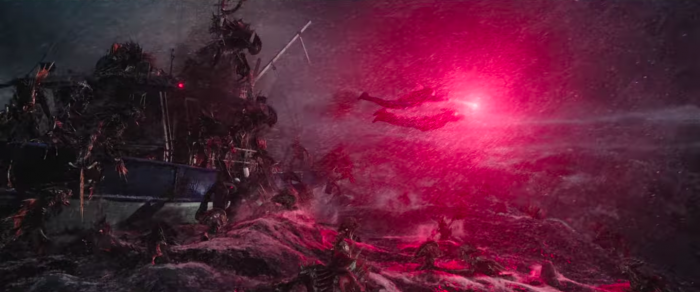 So, was the trench your opportunity to bring some of that James Wan horror into Aquaman?James Wan: Oh yeah.Because that shot in the Comic-Con footage is definitely right up your alley.James Wan: Yeah. I think it was that, that got me super excited for early on when I went in and spoke with the DC executives, and I said, "Wow, guys. We've got such great opportunity here to basically bring horror elements into a superhero world that we're not quite used to seeing in mainstream superhero universe. And, this naturally, organically lends itself to it. And if I was to come on board, that's what I would like to do." And, they were more than cool about that. Actually, they were very excited. They were like, "We love the idea of Aquaman versus sea monsters." And I was like, "Okay. I'm sold."Could you talk about that one shot we see in there, or seemingly one take shot? I'm sure it's a blend of a bunch of...James Wan: The one, with the long shot?Yeah.James Wan: What you saw in that piece, was only half of it.Wow.James Wan: I like to tell stories using my one shot to sort of link, sort of disparate some of the elements together. And in that sequence, as you can see, Arthur is dueling it out with Black Manta, while Mera is fighting her own battle with Atlantan commandos. And, I just didn't want to sort of like, cut this, cut to that, cut to that. I tried to create in a kind of seemingly smooth way of tying just the space together.
So, was the trench your opportunity to bring some of that James Wan horror into Aquaman?James Wan: Oh yeah.Because that shot in the Comic-Con footage is definitely right up your alley.James Wan: Yeah. I think it was that, that got me super excited for early on when I went in and spoke with the DC executives, and I said, "Wow, guys. We've got such great opportunity here to basically bring horror elements into a superhero world that we're not quite used to seeing in mainstream superhero universe. And, this naturally, organically lends itself to it. And if I was to come on board, that's what I would like to do." And, they were more than cool about that. Actually, they were very excited. They were like, "We love the idea of Aquaman versus sea monsters." And I was like, "Okay. I'm sold."Could you talk about that one shot we see in there, or seemingly one take shot? I'm sure it's a blend of a bunch of...James Wan: The one, with the long shot?Yeah.James Wan: What you saw in that piece, was only half of it.Wow.James Wan: I like to tell stories using my one shot to sort of link, sort of disparate some of the elements together. And in that sequence, as you can see, Arthur is dueling it out with Black Manta, while Mera is fighting her own battle with Atlantan commandos. And, I just didn't want to sort of like, cut this, cut to that, cut to that. I tried to create in a kind of seemingly smooth way of tying just the space together.
I do that a lot in my horror films, as well. I like to kind of show the world that you're in. All it takes is that one shot, and it gives you a perfect sort of geography of the space you're in, and that helps a lot of times with the action, or the scares that you're trying to build, and that kind of stuff is important for me. And I think for the kind of action that I do, and I try to do a bit of that, as well, even in my Fast and Furious film. I think letting the audience kind of know where they are, and doing it with a very, succinct filmmaking method is very important. I'm not just doing this because it looks cool, 'cause it's very hard to pull that off. I do it because I think it's an important piece of storytelling in the films that I do.
Yeah. It's just like the scope of the stakes.James Wan: Yeah. And just the geography, I think more importantly, so the audience is never sort of confused as to where they're at. I think that's very important, especially if you have two very different things going on at the same time.
On the next piece I'm gonna show you guys, is Nicole Kidman. And, I'm actually gonna show you guys the opening prologue to the film, 'cause this is very important for me because this shows how mom and dad meet. And why I think it's important is because, I'm gonna show you guys that for me, the love story of Arthur and Mera is important, but the love story of mom and dad, and how they meet, and fall in love, is just as important, if not more important. The emotion that we have with those two characters is the sort of the emotional backbone for the whole film. And my whole movie is sort of built around how Arthur feels because of how Atlantis has kind of has basically ... He has a chip on his shoulder with Atlantis because of what he blames Atlantis did to his mother. And so, that is like the backbone for the whole film. And I think, it's an important thing to kind of lay out because it sets up the whole movie.
We then were shown the opening prologue of the film featuring Nicole Kidman as Queen Atlanna, washing up on shore next to a lighthouse in a big storm. Aquaman provides a voice over, quoting Jules Verne and explaining the strange story of how his mother met his father. Thomas Curry, played by Temuera Morrison finds Atlanna washed up on the rocks and brings her into the house.
When she awakes, she immediately goes into a defensive as if she was in the middle of a battle. She throws a spear through the television, which is making loud noises. In the end, she ends up sleeping on the couch, and there is this very sweet moment between her and Thomas' dog — this is the first time she/s encountered such a creature.
She's truly a fish out of water, and what better way to nail this home than to have Atlanna go over to the fish tank and grab and eat a goldfish out of the water. Curry comments that he was going to make her eggs, and questions where she's from. Over tea, she tells him that she is the Queen of Atlantis, to which Thomas responds "Wow. I'm Tom, keeper of the lighthouse." This whole meet-cute sequence is not something you would have found in the Zack Sndyer DC films. On a more critical note, the de-aging visual effects on Kidman are not to the level of the Marvel films. But we were watching an unfinished work in progress cut, so that could change.
While I would have liked to see more of this relationship and bond grow, in true Wan style, the camera floats into a snow globe on the table transitioning into them on the top level of the lighthouse. She's now holding a baby, a kid that she says will unite our worlds one day. They take a family photo. We are now progressing in time. He's older, and she's telling him the backstory of Atlantis almost like a mother recites a fairy tale to her child before bedtime.
This is when the action kicks in. A huge hole is blown in the wall and a Stormtrooper-like army storms in demanding to take her back to Atlantis by order of the king. What follows might be the most impressive thing I saw in this editing room: an incredible one-shot fight sequence with Atlanna kicking ass throughout the entire house. This action scene alone got me excited to see the finished film, and I'll admit, I wasn't very excited about this movie from the Comic Con footage.
Atlanna has to leave but vows to return when it's safe, one day at sunrise. She asks Thomas to not let him forget her.
They fight with their tridents, water fields some resistance, causing bubbles, but in the end it's like a 360 fight between supermen. This action sequence was a little less exciting to me, with the two men dragging each other along underwater rocks, battling on top of hundred story tall statues, and Orm gets an advantage and is able to slice through Aquaman's trident. The thousands of Atlantians in the audience are cheering like its a sports event. Hera comes in a ship and rescues Aquaman before he is defeated in the battle.
***
Can you do all the wire work, as opposed to getting the actors actually in a water tank?James Wan: I don't really think I could get my actors to do that at the end of the day. *laughs* A lot of very difficult planning and really putting the actors through very vigorous training to work on those rigs and the wire work and all that stuff. First thing we did was just training the actors every day, trying to get their stamina up so that they can just go 12 hours a day. Just being in those harnesses, it's so painful, especially for someone like Momoa who's so big. So you can imagine how uncomfortable that is for him, especially for a guy because the rig goes like this (motions to how it wraps around in between the legs). For him, it's not the most pleasant thing.
And working with the stunt department, we'll do it in steps and stages. First, we'll sort of like design the fight on the floor and how it will move because that would be the easiest way. We lay it all out. And then we go, 'Okay, so now, we're not fighting on a dry surface. We have to think about the fact that gravity plays different now.' So now we go to the next step and then we now start to bring in wire work, the rigging and stuff like that. And so then we now have to translate what we laid out on the floor onto a different level of that, literally onto a different level of floating the actors and stuff like that. And then, of course, the final big step is really getting visual effects to come in and just really help us kind of create just stuff that I can't do otherwise.
There's a moment there where it's just like it's all one shot kind of thing, watching them fight and the camera just rips all around them. So we would do motion capture, getting the actors and the stunt department to kind of lay out the moves and capture the moves into a computer and then basically use the computer to, and what those guys do in visual effects, those geniuses just reanimate the world and then I can put my camera anywhere, which is so much fun. It's a kind of filmmaking I've never done before and so it's very exciting. It's a new piece or tool to add to my bag of tricks.
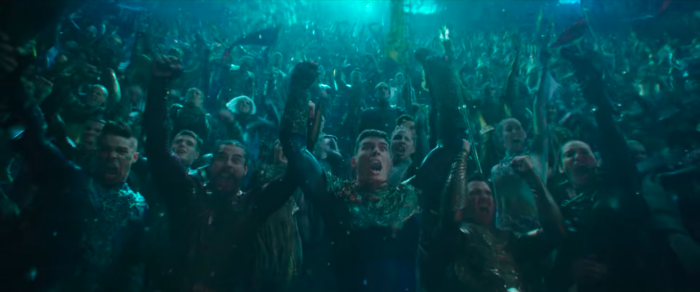 How much research and development went into the digital effects portion of this? Nobody's really ever done anything like this, not just in comic book movies, but in action blockbusters, period. Nobody's had to have massive action sequences underwater, so how extensive was the R&D, but then also the trial and error since you've gone into post?James Wan: A lot of it. We tried to kind of design it in pre-production and we would do lots of things. Even though we did a lot of dry for wet, but you know, we wanted to make sure that things somewhat authentic underwater as well. We would build costumes, sets, and our actors, we would literally submerge them underwater and we did so much study just to see what they would look like and the most surprising thing that we discovered very early on is people, objects, and stuff do not look we underwater. It only looks wet when you take it out of water. Right? When it's glistening and it's dripping wet that's how something looks wet. But when you're underwater, it actually looks matte and so that concept was a bit tricky for us to kind of wrap our head around, especially for me, because we'd constantly have to go in there and pat out actors down, like with makeup. Under those bright lights and all the stunts, they were constantly sweating and all that and you don't see water underwater. You don't see sweat, right? And so, as I said, it's such a weird thing to kind of wrap my head around early on. And so we did a lot of that and then, of course, we shoot as much of it as we can practically. We want to shoot as much [we can], because even if visual effects was to come in and augment a lot of it, right? They want to start with something that is real, that's tangible, that they kind of go see and can go 'Oh this is what would happen.' More importantly, it's how the actors and the stunt actors would react and act and so that was really important. And then in post-production, we try to take it ten notches up and make it even cooler, as much as we can.In all of the scenes that we've seen so far, it's funny. It's very funny. There's the octopus in this one. There's jokes between everybody.James Wan: Are you guys familiar with the comic book, like the 1960s Super Friends? Do you guys know Topo? He is a pet octopus. Don't write about that one. That's just for the fans. The hardcore fans out there go, 'Ah, Topo.' Because in the comic book, Topo would play all kinds of musical instruments, like literally one tentacle would be playing the harp and another would be playing the violin, and the other tentacle would be playing the piano. So this is my take on that. He's playing the massive set of those big sort of Japanese drums and stuff in a tribalistic kind of way. I joke that the octo-drummer should hook up with the guitar flame guy from Mad Max [Fury Road] and start their own band. I would pay to see that bandThat's a level of camp that we don't normally see, especially in DC movies. We don't usually get that sort of camp.James: Well, I've said since day one, any of you guys that have interviewed me from day one, I've always said 'I want to make a fun movie.' And I know back then everyone was like, 'Oh, he's saying fun because DC movies are so dark or whatever, right? And there's no fun.'
How much research and development went into the digital effects portion of this? Nobody's really ever done anything like this, not just in comic book movies, but in action blockbusters, period. Nobody's had to have massive action sequences underwater, so how extensive was the R&D, but then also the trial and error since you've gone into post?James Wan: A lot of it. We tried to kind of design it in pre-production and we would do lots of things. Even though we did a lot of dry for wet, but you know, we wanted to make sure that things somewhat authentic underwater as well. We would build costumes, sets, and our actors, we would literally submerge them underwater and we did so much study just to see what they would look like and the most surprising thing that we discovered very early on is people, objects, and stuff do not look we underwater. It only looks wet when you take it out of water. Right? When it's glistening and it's dripping wet that's how something looks wet. But when you're underwater, it actually looks matte and so that concept was a bit tricky for us to kind of wrap our head around, especially for me, because we'd constantly have to go in there and pat out actors down, like with makeup. Under those bright lights and all the stunts, they were constantly sweating and all that and you don't see water underwater. You don't see sweat, right? And so, as I said, it's such a weird thing to kind of wrap my head around early on. And so we did a lot of that and then, of course, we shoot as much of it as we can practically. We want to shoot as much [we can], because even if visual effects was to come in and augment a lot of it, right? They want to start with something that is real, that's tangible, that they kind of go see and can go 'Oh this is what would happen.' More importantly, it's how the actors and the stunt actors would react and act and so that was really important. And then in post-production, we try to take it ten notches up and make it even cooler, as much as we can.In all of the scenes that we've seen so far, it's funny. It's very funny. There's the octopus in this one. There's jokes between everybody.James Wan: Are you guys familiar with the comic book, like the 1960s Super Friends? Do you guys know Topo? He is a pet octopus. Don't write about that one. That's just for the fans. The hardcore fans out there go, 'Ah, Topo.' Because in the comic book, Topo would play all kinds of musical instruments, like literally one tentacle would be playing the harp and another would be playing the violin, and the other tentacle would be playing the piano. So this is my take on that. He's playing the massive set of those big sort of Japanese drums and stuff in a tribalistic kind of way. I joke that the octo-drummer should hook up with the guitar flame guy from Mad Max [Fury Road] and start their own band. I would pay to see that bandThat's a level of camp that we don't normally see, especially in DC movies. We don't usually get that sort of camp.James: Well, I've said since day one, any of you guys that have interviewed me from day one, I've always said 'I want to make a fun movie.' And I know back then everyone was like, 'Oh, he's saying fun because DC movies are so dark or whatever, right? And there's no fun.'
I'm like, 'No! You're making a movie about Aquaman!' He talks to fish and stuff like that. You gotta lean into that. You gotta not be afraid of the camp of it all, but the key is try and make it cool, right? The key is to try and make it something that you can kind of smile at it, but then kind of go, 'Oh, that's kind of fun. That's awesome!' That is my job to try and take what collectively we all know from pop culture, the lamest superhero, and have fun with him and make him the freakin' coolest superhero I can. That's my dream. My dream is to make him cooler than Batman and Superman, so that's just me.
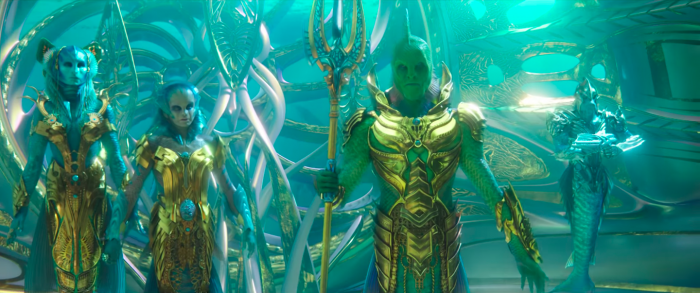 I totally got a lot of broad strokes of the feel of films like Labyrinth or even The Princess Bride, going into Indiana Jones and stuff with how you're balancing the different genres and sub-genres between action/adventure, romance, action, comedy. Can you talk about how that's all anchored within overall theme of the film being he is the son of the land and of the sea and how you tapped into the mythology?James Wan: Yes, definitely. I can answer that in two ways. The next scene that I wanna show you guys kind of showcases how [Aquaman] to me, without being too on the nose, it's a fish out of water story. When he's in Atlantis, he's the fish out of water, but when they go on land, Mera is the one that's fish out of water. This next scene I want to show you guys, because I think it's important for me to show you a bit of the relationship between Arthur and Mera, which is such a big thing in the comic book world, but also my pitch from day one which is, 'I want to make my Indiana Jones, my Romancing the Stone.' And so it has shades of that and also it touches a little bit too about the other thing that I think is important in a movie like Aquaman is you kind of have to touch on the world of the environment and how that is such a big part of the reason why Orm wants to declare war is he's finally so sick of the shit that we do in the surface world and how all that stuff literally flows down into them. I think that's something that we can all relate to.
I totally got a lot of broad strokes of the feel of films like Labyrinth or even The Princess Bride, going into Indiana Jones and stuff with how you're balancing the different genres and sub-genres between action/adventure, romance, action, comedy. Can you talk about how that's all anchored within overall theme of the film being he is the son of the land and of the sea and how you tapped into the mythology?James Wan: Yes, definitely. I can answer that in two ways. The next scene that I wanna show you guys kind of showcases how [Aquaman] to me, without being too on the nose, it's a fish out of water story. When he's in Atlantis, he's the fish out of water, but when they go on land, Mera is the one that's fish out of water. This next scene I want to show you guys, because I think it's important for me to show you a bit of the relationship between Arthur and Mera, which is such a big thing in the comic book world, but also my pitch from day one which is, 'I want to make my Indiana Jones, my Romancing the Stone.' And so it has shades of that and also it touches a little bit too about the other thing that I think is important in a movie like Aquaman is you kind of have to touch on the world of the environment and how that is such a big part of the reason why Orm wants to declare war is he's finally so sick of the shit that we do in the surface world and how all that stuff literally flows down into them. I think that's something that we can all relate to.
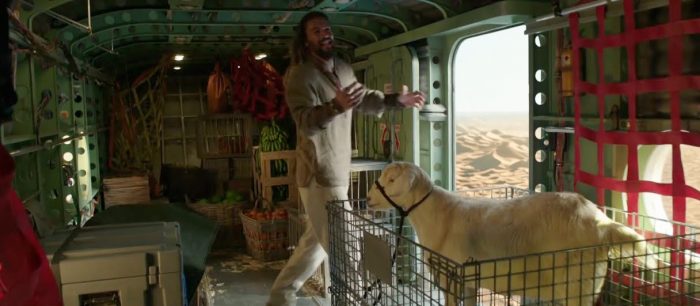
James then showed us another scene, this one to show us a little about Aquaman and Hera's dynamic. They are both in a cargo plane flying over the desert, and they decide to jump out. They fall into the sand dunes and land like explosions. This film doesn't take itself too seriously, and I'm enjoying that. Hera uses a a holographic tracker to find one of the lost tribes of Atlantis who dried up when the water did. She complains about how the human world is destroying the planet, and he tries to convince her to not judge his world. I think it's interesting that they decide to talk about the effects man has put on this planet and not completely sidestep the issue. I give them some extra credit for that.
I think their dynamic is supposed to be this fun back and forth, bickering rappor,t but I saw very little chemistry between the two actors. It came off more like awkward arguing than what I imagine they were going for. They eventually fall through a hole into the kingdom of the deserts, an old dried up world below the sand. This whole clip felt very much like a National Treasure-style adventure movie to me, and if this film has more of that, I'll be very happy.
***
James Wan: When he's in Atlantis he's the Fish out of water but when they go on land Mera is the fish out of water. I think it's important to share this scene between Arthur and Mera which is such a big thing in the comic book world. My pitch from day one was I wanna make my Indiana Jones, my Romancing the Stone and so it has shades of that. It also touches on the other thing that I think is important in a film like Aquaman. You kind of have to touch on the world of the environment and how that is such a big part of the reason why Orim wants to declare war. He's so sick of the shit we do on the surface world and what we do. How literally all that flows down to them and I think that' something we can all relate to. Can you talk about the editing process? I know there was a screening last week and that it was 2 hours and a half.James Wan: It's not 2 and a half hours. These one shots I'm assuming are very hard to edit. The transitions between scenes.James Wan: It's always hard when you have arranged transitions between scenes. The transitions are part of my aesthetic and stylized filmmaking. It does make it tricky–to go 'yeah I planned to go from this scene to this scene'. I try not to let the tail wag the dog at the end of the day and let the movie be what it is, right? If I can retain the texture of my original vision, I try to stick as close to that as I can. I think that's the kind of stuff that once the movie is out years later, people will appreciate and go back to. Just the little detail touches that they did and I think that's important. Has there been a lot of change to this film from first draft to where it's at up to this point?James Wan: I mean things kind of progress. It's kind of the movie I've wanted to tell from day one. Story points change. When things got more expansive we tried to pack in a little bit more, when things got too big we'd cull it back a bit more or in a big way. Sometimes you go 'we wanna go this way instead of this way' but then end goal was always the same. We always knew going into this film that the movie is about this and we want to get to here. It became a question of like mechanics, 'how do we get to there and what is the most fun way and the most emotionally engaging way to get to that point?"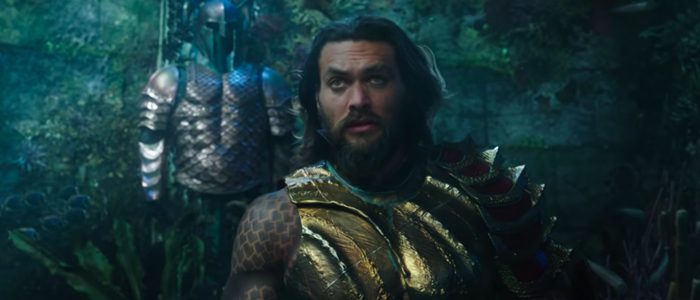 It great to see Jason Momoa as Aquaman again. Can you talk about crafting the character with Jason, it seems so naturally his presence.James Wan: That was the most important thing going into it. I knew I didn't necessarily want to make the whole movie with where his character left off in Justice League. I think that might be too heavy to just follow a guy who's just kind of you know just that heaviness of it. When I first met Jason I was kind of blown away by how funny he was and how charismatic he is in person like 'Dude, I wanna bring that into the screen. I wanna see more of you, see more of your own personality in the movie and that's what we did. I went back to my writers and we would do things and shape the script. We wrote it more for Jason. It actually made it easier for us to write because we'd go 'Momoa would never say the line like this. He's say it more like that.' It was great because it made it easier for me to write it and ultimately it just gives the film more personality by bringing his personality out. Now Jason will always say that I took him out of his comfort zone because that's not what he's known for. There were few moments when I was directing him that I said, 'Jason, you're playing this a bit too angry' and he'd look at me and say, 'James this is what they paid me money to do! Khal Drogo! That's why they paid me' I'd say 'Great, that's good for Khal Drogo. We're creating a very different character here and there will be very many moments in the movie where you'll be able to be really tough but in this moment I wanna see you more of that light-hearted goofiness of you that is gonna service the movie well'."
It great to see Jason Momoa as Aquaman again. Can you talk about crafting the character with Jason, it seems so naturally his presence.James Wan: That was the most important thing going into it. I knew I didn't necessarily want to make the whole movie with where his character left off in Justice League. I think that might be too heavy to just follow a guy who's just kind of you know just that heaviness of it. When I first met Jason I was kind of blown away by how funny he was and how charismatic he is in person like 'Dude, I wanna bring that into the screen. I wanna see more of you, see more of your own personality in the movie and that's what we did. I went back to my writers and we would do things and shape the script. We wrote it more for Jason. It actually made it easier for us to write because we'd go 'Momoa would never say the line like this. He's say it more like that.' It was great because it made it easier for me to write it and ultimately it just gives the film more personality by bringing his personality out. Now Jason will always say that I took him out of his comfort zone because that's not what he's known for. There were few moments when I was directing him that I said, 'Jason, you're playing this a bit too angry' and he'd look at me and say, 'James this is what they paid me money to do! Khal Drogo! That's why they paid me' I'd say 'Great, that's good for Khal Drogo. We're creating a very different character here and there will be very many moments in the movie where you'll be able to be really tough but in this moment I wanna see you more of that light-hearted goofiness of you that is gonna service the movie well'."
***
I came away from this editing room visit being much more excited about Aquaman. I think it's a combination of James Wan's signature style action, the fun and sometimes silly take on the property, and the almost National Treasure-style adventure story. That one-shot action scene featuring Nicole Kidman was particularly impressive, and I can't wait to see that again, next time on the big screen.
I'm more optimistic about Aquaman after seeing this footage, but still with some hesitations. Jason Momoa kills it when he's having fun and not trying to be dark and brooding. I'm not sure if the dynamic between him and Amber Heard works in the way they wanted, but maybe I just have to see more. And the scenes seemed to widely vary in tone, so I'm curious to see how it flows in the larger scope of the film.
Aquaman hits theaters on December 14, 2018, and we'll have more on the movie soon.

